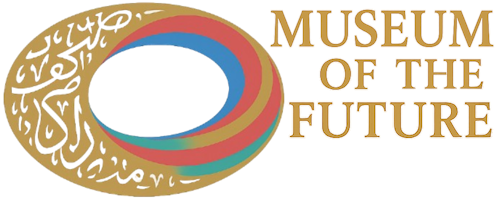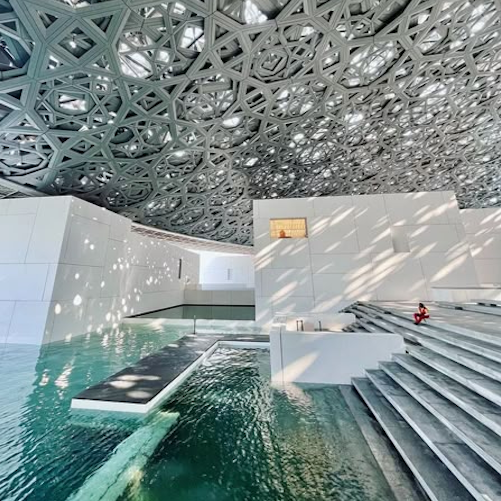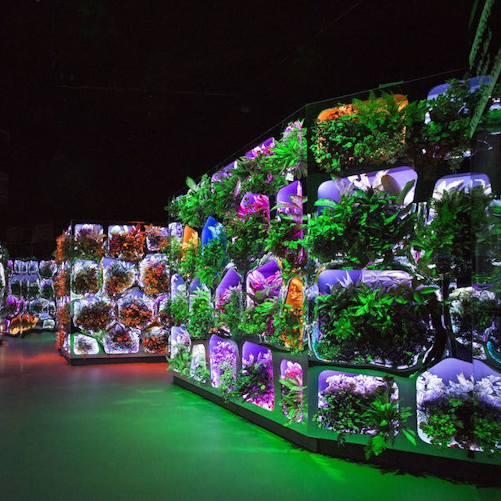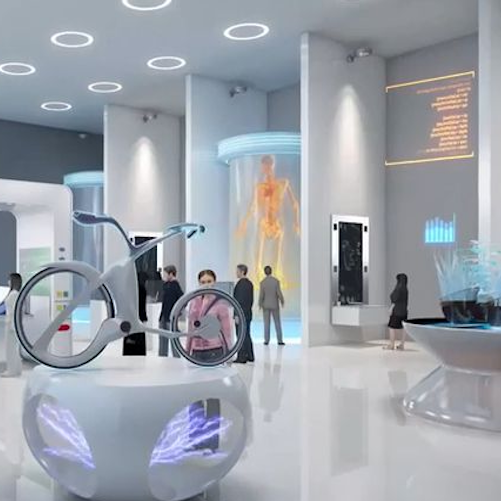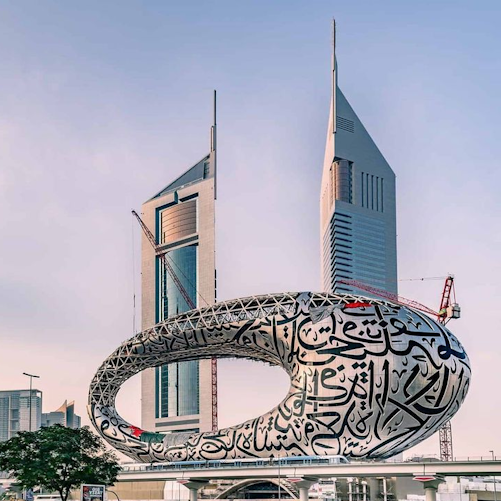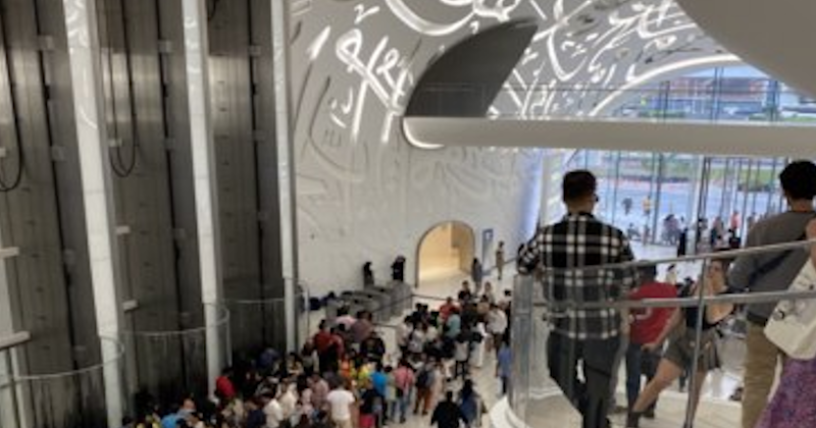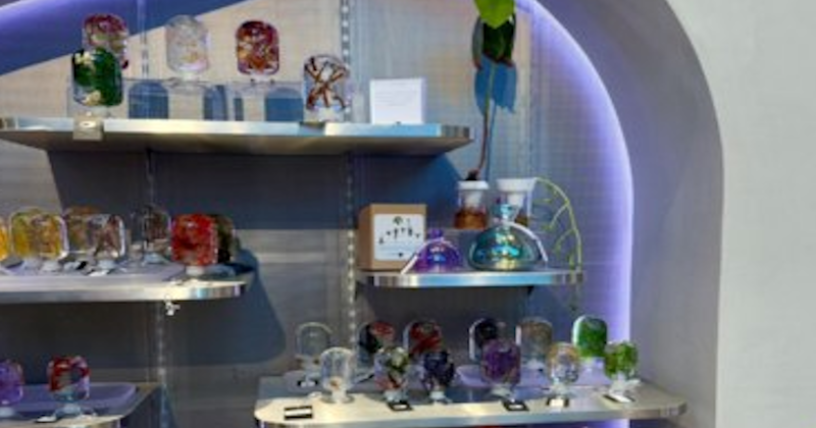Tickets
Tours
Reviews
I recently visited the Museum of the Future in Dubai, and it was simply amazing! You can immediately feel the atmosphere of innovation and technology. The exhibits cover a wide range of topics, from artificial intelligence to sustainable development. I was particularly impressed by the area dedicated to space exploration: the opportunity to glimpse the future of interplanetary travel left a lasting impression.

Jonathan Reed, 38
An impressive structure. You can come and just look around and take pictures of the museum's impressive lobby. The metro is nearby and easy to reach. The exhibition is best viewed by those who know English or Arabic (all explanations are in these languages). If you exit from the opposite entrance from the main entrance and cross a small road, there is a small garden with peacocks.

Anna Thompson, 31
The museum is superb! The building is very beautiful, and the exhibits are interesting. There is a separate fee for photos on the roof. It is best to visit in the morning. Before opening, you can see and take photos with peacocks. We purchased tickets in advance through Tripster to select the desired time.

Daniel Lee, 34
From the outside, it looks like something out of a movie about the future — truly impressive. The interior is also impressive: space, technology, artificial intelligence, nature, and there is even a room for meditation and mental health. Everything is beautiful, modern, and atmospheric.
If you want inspiration and to feel like you're in the future, be sure to go. It's best to buy tickets in advance and arrive on time — everything runs on schedule.

Rachel Clark, 42
Overview
Located in the heart of Dubai, the Museum of the Future is a futuristic building that showcases cutting-edge technology and interactive exhibits. The museum’s design is inspired by the concept of a “time capsule” and aims to give visitors a glimpse into the future of science, technology, and innovation.
One of the most interesting features of the Museum of the Future is its immersive exhibits. Visitors can interact with holograms, augmented reality displays, and virtual reality, allowing them to explore the future in a hands-on and engaging way. The exhibits cover a wide range of topics, from space exploration to artificial intelligence, and are designed to be accessible to visitors of all ages and educational backgrounds.
In addition to interactive exhibits, the Museum of the Future hosts a range of educational programs and workshops. These programs are designed to inspire the next generation of scientists, engineers, and innovators, and include events such as coding workshops, 3D printing, and robotics demonstrations.
Overall, the Museum of the Future in Dubai is a one-of-a-kind museum that offers visitors a unique and inspiring experience. Its focus on the future of science and technology aligns with Dubai’s vision as a leading global hub for innovation and is sure to attract visitors from around the world.
If you are planning a trip to Dubai, the Museum of the Future is definitely worth a visit. Whether you are interested in space exploration, robotics, or artificial intelligence, you are sure to find something fascinating in this modern museum. So why not come and see for yourself what the future holds?
Ticket prices
- General admission tickets to the future — AED 159
- Children’s admission ticket (under 4 years old) — FREE
- PIONEER PASS Special Powered by Visa — AED 399
The building
The building is an architectural and engineering marvel. It confidently strides into the future while embracing the past, applying cutting-edge technology to traditional art forms. The building “speaks Arabic”: its facade is a canvas for the poetry of His Highness Sheikh Mohammed bin Rashid Al Maktoum, written in the calligraphic style of Mattar bin Lahij.
The building’s shape is futuristic: it breaks new ground away from the high-rise towers that dominate the skyline everywhere. Its shape is symbolic: the circular building represents humanity; the green hill on which it stands represents the earth; the void represents the unknown future.
Vision
The museum is a house of inspiration, open to all. We present the vision of His Highness Sheikh Mohammed bin Rashid Al Maktoum, showing what is possible with conviction, commitment, and unity. Our goal is to bring light to dark times: in an era of anxiety and cynicism about the future, we show that everything can and must evolve.
Our imagined future inspires hope, but we are also honest about the dangers of the present. Through our exhibitions, publications, films, and public events, we will show how the problems of today can serve as raw material for creating a better world.
Experience
This is not a traditional museum with ancient relics behind velvet ropes. It is a gateway to a future world created by visionary designers, artists, and filmmakers. The museum combines elements of an exhibition, immersive theater, and a themed attraction. Each floor is like a film set from the future that you can inhabit, explore, and interact with.
The settings and scenes we create are immersive, but also expansive: they are designed to expand what viewers believe is possible — for the world, for the future, and for themselves. This content was created by a team of world-leading product, media, exhibition, and experience designers.
Dubai Future Foundation
The Dubai Future Foundation was established in 2016 by His Highness Sheikh Mohammed bin Rashid Al Maktoum, Vice President and Prime Minister of the UAE and Ruler of Dubai, to institutionalize the shaping of the future.
Imagining, designing, and realizing the future of Dubai is the Foundation’s central mission. Risk-taking, speed, and foresight are the key qualities that define the Foundation’s path to success.
The Foundation was born out of the belief that leadership in the present is not enough. It is the future that we must imagine, design, and implement.
The Museum of the Future is an initiative of the Dubai Future Foundation.
Initiatives
On June 30, 2015, Dubai announced plans to build the world’s first fully functional office building printed in 3D. This project was the first major initiative of the Museum of the Future. The single-story, 2,700-square-foot office of the future opened in 2016 on the museum grounds. It took 17 days to print, “using an additive method of ‘printing’ concrete on a 3D printer 20 feet high, 120 feet long, and 40 feet wide,” and two days to move and install, with “subsequent construction services, interiors, and landscaping taking about three months.”
On February 17, 2016, the Dubai Future Foundation announced the creation of a Global Blockchain Council to study and discuss current and future applications, as well as to organize transactions using the blockchain platform.
On March 28, 2016, the Dubai Future Foundation launched the Mostaqbal Portal, an initiative to provide daily coverage of the latest technological and scientific achievements by publishing research, scientific findings, visual materials, and infographics in Arabic in a simplified and easy-to-understand language.
Dubai Metaverse
The Dubai Metaverse took place at the Museum of the Future and the Emirates Towers. It was initiated as the first initiative of the Dubai Metaverse Strategy, adopted by Mohammed bin Rashid Al Maktoum with the aim of making Dubai one of the ten largest economies in the metaverse. The forum was attended by more than 300 experts and politicians in the field. Among other recent events, seminars, and sessions, the virtual headquarters of the Ministry of Economy of the United Arab Emirates was demonstrated.
Basic rules
- Select a suitable time to visit and pay for your ticket
- Check that tickets have been booked for all visitors, including children under 3 years of age.
- Receive an e-ticket voucher with a QR code by email
- Arrive 30-60 minutes before the time indicated on the ticket
- Exchange the voucher for a ticket wristband at the ticket office or self-service kiosk
- Enjoy the exhibition!
How to get to the Museum of the Future?
Location: The Museum of the Future is located in the immediate vicinity of Jumeirah Emirates Towers in Dubai, United Arab Emirates.
Public transport
MRad Emirates Towers
We recommend using the Dubai Metro for the best access (Emirates Towers station, red line). A connecting bridge links the metro station directly to the museum. You can also use the Dubai bus service network. The best service lines are as follows:
- 27
- 29
- X22
Arriving by car
You can use your own car and park on site (subject to availability) or use the valet parking service.
Other transport options
You can also get there on foot, by bike or electric scooter and use the bike racks located in the self-parking area. We also have drop-off zones around the museum.
Taxi
Architecture
Thanks to its unique design, the Dubai Museum of the Future became famous far beyond the country’s borders even before its opening, becoming part of the city’s iconic architecture. The building is undoubtedly one of the most complex structures in the world. It is designed as a curved diagonal grid frame without internal supports.
The design was led by Sean Killa, a local company called Killa Design. He won a specially announced competition in 2015. The work involved complex, algorithm-based parametric design, 3D modeling, and laser projections, as it was impossible to create an “object of the future” using traditional methods of drawing two-dimensional blueprints. The designers had to radically upgrade their skills.
The construction contractor was BAM International, which had to use high-tech equipment to erect such an unusual building. High-precision computer-controlled robotics were used to manufacture the exterior elements.
More than 1,000 lightweight, carefully fitted facade panels made of steel and fiberglass, covering 2,400 diagonally intersecting metal elements, were manufactured in a unique design inspired by aviation. None of them are duplicates. The outer shell provides the building with the highest level of waterproofing and airtightness. During the day, its smooth surfaces take on silvery and golden hues, while at night they are brightly illuminated by LED lights that accumulate solar energy.
The streamlined shape of the torus with a variable cross-section (or “eye looking into the future”) was inspired by feng shui practices. The structure itself is associated with the Earth and the Sky, and the empty space in the center with the Unknown. The only horizontal surfaces are the floors of the seven main levels of the exhibition space and the three underground floors, which are used for parking. The museum of the future is connected by a footbridge to the metro station and a gallery between the Emirates Towers.
The Arabic calligraphy inscribed on the outside of the torus and running along the entire facade is a statement by the Emir of Dubai, Prime Minister and Vice President of the UAE, Mohammed bin Rashid Al Maktoum, or simply Sheikh Mohammed, about the future of the country.
We may not live for hundreds of years, but the products of our creativity can leave a legacy long after we are gone… The future belongs to those who can imagine it, design it, and make it happen. The future does not wait. It can be built today.
The style of the inscriptions was developed by Emirati calligrapher Muter bin Lahaj, and the cursive characters themselves were made of transparent glass. The halls offer stunning panoramic views of Dubai, placing the Museum of the Future on a par with the observation decks of the Dubai Frame and Burj Khalifa. In the evening, you can see the light shining through the “calligraphy” from the street.
At the base of the museum is a rounded trapezoidal cushion covered with a grass carpet and separated from the highway by greenery. It contains the entrance archway. Capsule elevators are installed inside the building to take visitors to the upper levels.
Next to this unusual structure is a mirrored pool, bicycle paths, and a recreation area. The museum is powered by a solar power plant.
What is inside the Museum of the Future?
- Space, called OSS Hope, 5th floor. Here you can see fantasies and real designs on the theme of human exploration of other planets and the future construction of the Hope orbital station. The bestseller among tourists is a space suit in the shape of a pink bear. It is claimed that it is real, i.e., it works and can be used on other planets. A spacesuit in the form of a pink bear. By the way, the United Arab Emirates’ successes in space exploration are impressive. They have already launched the Hope probe to Mars. However, they did not launch it themselves; the Japanese launched it for them, and the Americans assembled the probe. The first Emirati astronaut has been to space, and the second will fly in the near future. The UAE has truly “Napoleonic” plans for space. They have even announced that they will build a colony on Mars by 2050. The first part of the Museum of the Future exhibition is dedicated to technologies and fantasies about how all this will happen.
- The ecological section is called the HEAL Institute and is located on the 4th floor. This part is dedicated to biology and ecology. There is a large DNA library hall with information and genomes of 2,400 interesting animal species. A separate hall showcases the most interesting ecosystems on our planet. All information is presented in English, so most of our tourists don’t understand much here.
- Dedicated to the power of the human mind and body, it is called Al Waha, 3rd floor. It is an impressionistic space where you can dance, think, and do many other things. It is even difficult to describe accurately; you have to see it with your own eyes. According to the museum’s organizers, people heal their bodies and souls here.
- Dedicated to the lives of people in the future, it is called “Tomorrow Today,” on the 2nd floor. Here you can see how the UAE authorities envision life in their country in 50 years. You can see flying automatic taxis and other futuristic vehicles. You can see photos of Dubai in 50 years — what multi-storey interchanges and lines for flying cars will look like here. Part of the exhibition is dedicated to robotics.
- For children, there is Future Heroes on the 1st floor. Here, children can play and learn at the same time. This concept is called “edutainment” — a fusion of the English words “education” and “entertainment.” Children find it very interesting here. The area is large, with dozens of activities for all ages and interests. Some of the activities are interactive and are conducted only in Arabic and English. The area is intended for children 10 years old and younger. Although security is not very strict, they do not ask for documents, but determine age by eye.
FAQ
Question: Is it worth visiting the Museum of the Future?
Answer: The Museum of the Future (Dubai) — everything you need to know before visiting. Children under 8 are unlikely to miss this place, while most adults will find it a little boring. Nevertheless, it is worth a visit, if only for the building. Two hours is more than you need. Tickets must be booked in advance.
Question: What is the Museum of the Future?
Answer: It is a gateway to the world of the future, created by visionary designers, artists, and filmmakers. The museum combines elements of an exhibition, immersive theater, and a themed attraction. Each floor is like a film set from the future that you can inhabit, explore, and interact with.
Question: Has the Museum of the Future opened?
Answer: On February 10, 2017, and February 9, 2018, the Museum of the Future temporarily opened at Madinat Jumeirah during the World Government Summit. On February 22, 2022, the Museum of the Future officially opened at 7 p.m. Dubai time.
Question: Where is the Museum of the Future located?
Answer: One of Dubai’s most famous landmarks, the Museum of the Future (MOTF) occupies a prominent place on the city’s superhighway, Sheikh Zayed Road.
Question: How much time should I spend at the Museum of the Future?
Answer: A visit to the Museum of the Future usually takes between 2 and 3 hours.
Questions: How big is the Museum of the Future?
Answers: The Museum of the Future is 77 meters/225 feet high and has a total area of 30,548 m2.
Questions: Can you go inside the Museum of the Future?
Answers: All visitors, including those eligible for free admission, must reserve a time slot to enter the museum. Tickets provide full access to the museum and its amenities.
Questions: What languages are spoken at the Museum of the Future?
Answers: The Museum of the Future does not provide sign language interpreters, but all audio materials are subtitled in Arabic and English.
Questions: How is the Museum of the Future built?
Answers: The building was constructed using robotic technology with a focus on sustainability and is powered by 4,000 megawatts of solar energy. The column-free design provides visitors with a window through which they can see the future in all its aspects and dimensions.
Questions: What are the special features of the Museum of the Future?
Answers: Three floors of immersive exhibitions will be dedicated to the possible future of space exploration, ecosystems, and bioengineering, as well as health, well-being, and spirituality.
Top Activities in Dubai
Blog
-
9 September, 2025
-
15 August, 2025
